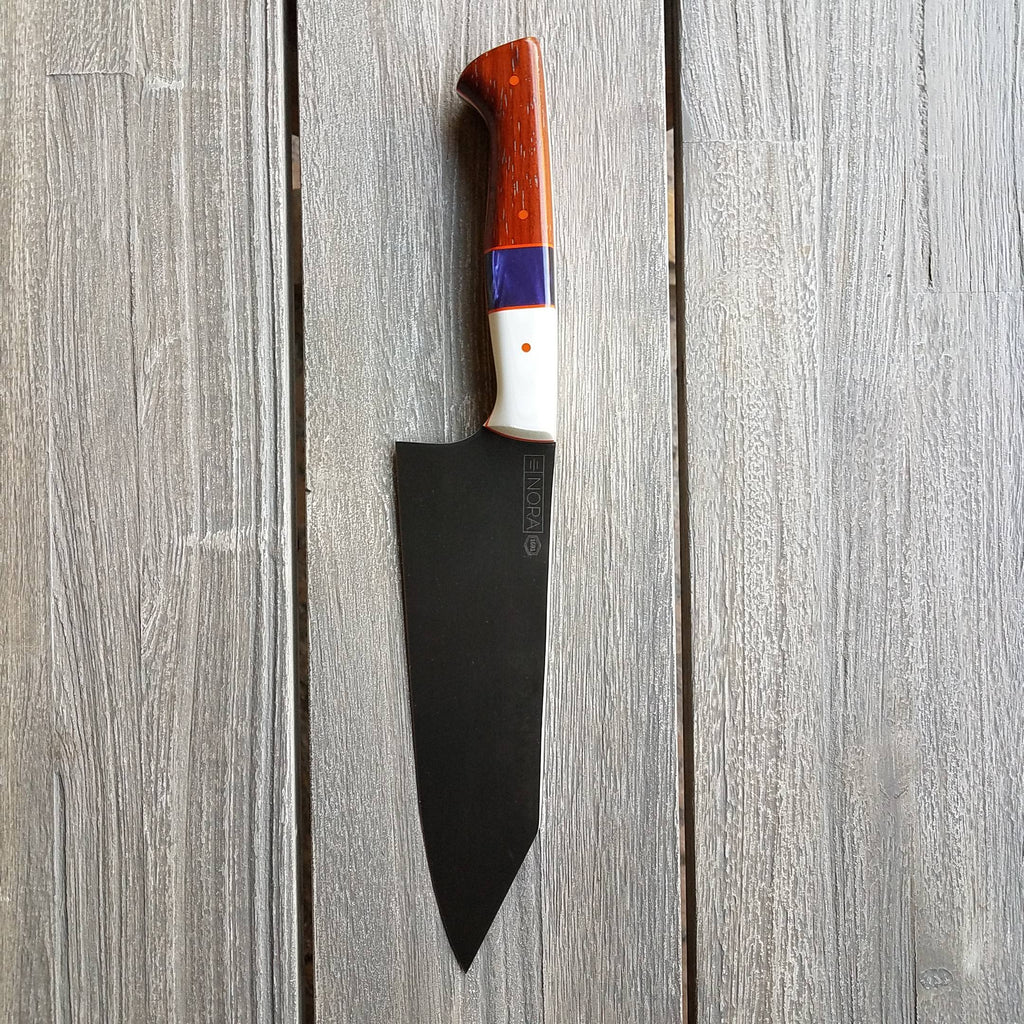
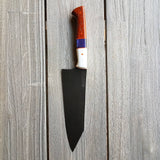
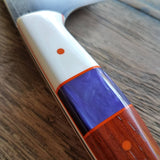
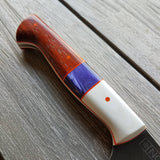
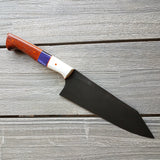
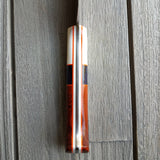
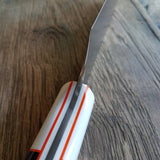
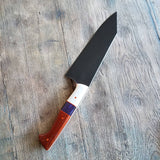
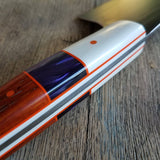
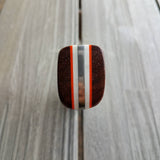
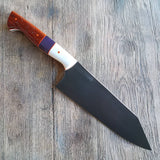
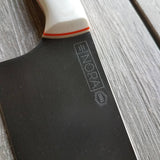
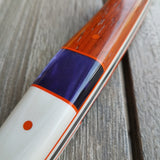
NORA #1691 - 7.5" CPM-M4 Kiritsuke - Padauk | Purple | White | Orange
$ 503.85
- Blade Type: Kiritsuke
- Blade Length: 7.5 Inches
- Total Length: 12.5 Inches
- Handle Style: Western | Right or Left Hand Use
- Steel: AEB-L Stainless Steel
- Handle Materials: Stabilized Padauk Wood, White G10, Royal Purple Kirinite and White & Orange G10 Spacers/Liners, Orange G10 Pins
- Rockwell Hardness: 66 HRC
- Grind Type: Full Flat
- This Blade is Ground...
- Thin for Performance (Best performance, but delicate)
- Thick for Durability (tough, built to last for heavy wear-n-tear)
- >>> Mid-Range with Special Geometry (specially ground for food release and glide but blade is kept slightly thicker for durability)
- This Knife Feels...
- Heavy in Hand (hefty, durable)
- Light (nimble, maneuverable)
- >>>Not too heavy, not too light (Switzerland)
GENERAL USES OF THIS KNIFE:
KIRITSUKE KNIFE:
This blade design is our take on the traditional Japanese Kiritsuke knife.
A Kiritsuke knife is one of the very few Japanese knives that is considered multi-purpose. It is a hybrid between a Yanagi (fish slicer) and a Usuba (vegetable knife.). A Kiritsuke knife works well for slicing and breaking down protein but it also excels at vegetable prep. and general purpose tasks. In Japanese kitchens, the Kiritsuke knife is reserved only for the executive Chef as a sign of respect and also due to the skill needed to efficiently use these knives.
Our Kiritsuke design does not have as flat of a belly as the more traditional Japanese style knives. We have done this to allow just the slightest amount of rock in the cut. We feel it adds a bit more versatility to the knife.
HANDLE DESIGN & MATERIALS:
Every one of our knives is handmade, unique and numbered. NORA #1691 is a mix of stabilized African padauk wood, white G10, and a shimmering piece of royal purple Kirinite which is a proprietary acrylic composite.
G10 is an incredibly strong & durable fiberglass laminate that was originally used in the electronics industry. It has been adapted in the knife making world and has proven to be an excellent material for handles as it has high strength, low moisture absorption and can be found in a variety of colors. Its one of our favorite materials to work with outside of wood.
We like the punchy contrast of the white and purple against the clay color of the Padauk wood. Note that this wood starts as a bright orangey-red when initially cut and then slowly darkens to a deep reddish brown over time.
As mentioned above, the padauk wood is stabilized. Wood stabilization is an added feature that we offer with our knives. Wood that is stabilized has been injected with a clear acrylic resin under a vacuum process. Stabilization helps to minimize, if not eliminate, any cracking, warping, shrinkage and/or expanding of the material. Stabilized wood will absorb very little water and is generally impervious to oils. The process helps to ensure your knife has a long lifespan in the kitchen.
STEEL INFORMATION:
CPM- M4 CARBON STEEL
The blade on this knife is composed of a high carbon CPM M4 steel. M4 is the best carbon steel we have ever used in regards to blade performance. After doing a wide amount of research on this steel, we decided to give it a go and have been extremely impressed with its performance thus far.
CPM M4 steel can be treated to a very high hardness. Hardness in steel generally equates to a finer edge and great edge retention. We took this blade to a solid 66 HRC which is incredibly hard compared to most production knives which fall in the mid to high 50's.
The high hardness allows amazing edge retention but, unlike other steels at this hardness, it's not as brittle or delicate. It is actually highly wear resistant which means you don't need to worry as much about the knife chipping or breaking. (relative to other high hardness carbon steels) As an added bonus, M4 is surprisingly corrosion resistant when compared to other carbon steels.
It's a rugged knife for the performance it offers and this combination is rare when you harden steel to beyond 62 HRC. Please note though that the steel isn't bullet-proof...if you drop the knife on a very hard surface or try to muscle it through a very hard object (i.e. hard gourd, thick bones, etc.), it is likely to chip.
The pros of this steel outweigh the cons, but it must be mentioned that this steel is harder to sharpen than many others so you will need to factor that into your decision. It does represent a bit more maintenance than other knives. On the flip side, you don't need to sharpen this knife nearly as frequently as others.
**As this is a carbon steel, the blade will form a slight patina over time. This is normal and is actually the mark of a beautifully used knife. Please note, however, that a carbon knife does require more maintenance than its stainless steel counterpart, mainly that it must be washed or wiped clean shortly after each use to prevent unwanted rust or stains. We have acid etched this knife to protect the steel and start the patina process. Over time this etch will fade slightly and will be replaced by the individual patina you make while using the knife. Note that the etch will initially cause a slight amount of drag with the blade while cutting. This will fade with use but if it bothers you significantly you can use the rough end of a sponge to smooth the blade but just note that this will also more quickly degrade the etch and darker color of the blade.
